snow chains TOYOTA HIGHLANDER HYBRID 2020 Warranties & Maintenance Guides (in English)
[x] Cancel search | Manufacturer: TOYOTA, Model Year: 2020, Model line: HIGHLANDER HYBRID, Model: TOYOTA HIGHLANDER HYBRID 2020Pages: 260, PDF Size: 8.54 MB
Page 46 of 260
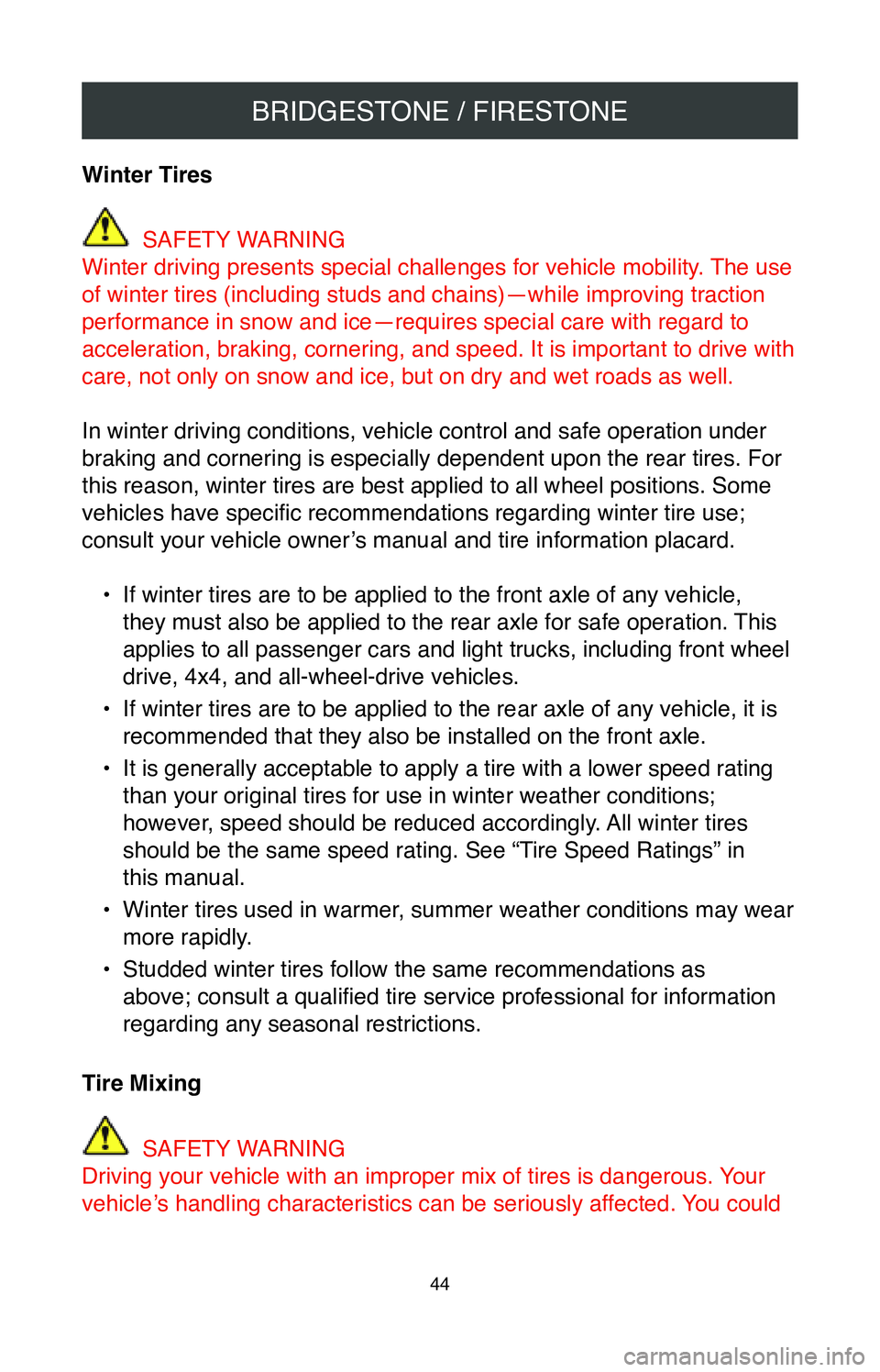
BRIDGESTONE / FIRESTONE
44
Winter Tires
SAFETY WARNING
Winter driving presents special challenges for vehicle mobility. The use
of winter tires (including studs and chains)—while improving traction
performance in snow and ice—requires special care with regard to
acceleration, braking, cornering, and speed. It is important to drive wi\
th
care, not only on snow and ice, but on dry and wet roads as well.
In winter driving conditions, vehicle control and safe operation under
braking and cornering is especially dependent upon the rear tires. For
this reason, winter tires are best applied to all wheel positions. Some \
vehicles have specific recommendations regarding winter tire use;
consult your vehicle owner’s manual and tire information placard.
•
If winter tires are to be applied to the front axle of any vehicle,
they must also be applied to the rear axle for safe operation. This
applies to all passenger cars and light trucks, including front wheel
drive, 4x4, and all-wheel-drive vehicles.
•
If winter tires are to be applied to the rear axle of any vehicle, it is\
recommended that they also be installed on the front axle.
•
It is generally acceptable to apply a tire with a lower speed rating
than your original tires for use in winter weather conditions;
however, speed should be reduced accordingly. All winter tires
should be the same speed rating. See “Tire Speed Ratings” in
this manual.
•
Winter tires used in warmer, summer weather conditions may wear
more rapidly.
•
Studded winter tires follow the same recommendations as
above; consult a qualified tire service professional for information
regarding any seasonal restrictions.
Tire Mixing
SAFETY WARNING
Driving your vehicle with an improper mix of tires is dangerous. Your
vehicle’s handling characteristics can be seriously affected. You could
Page 69 of 260
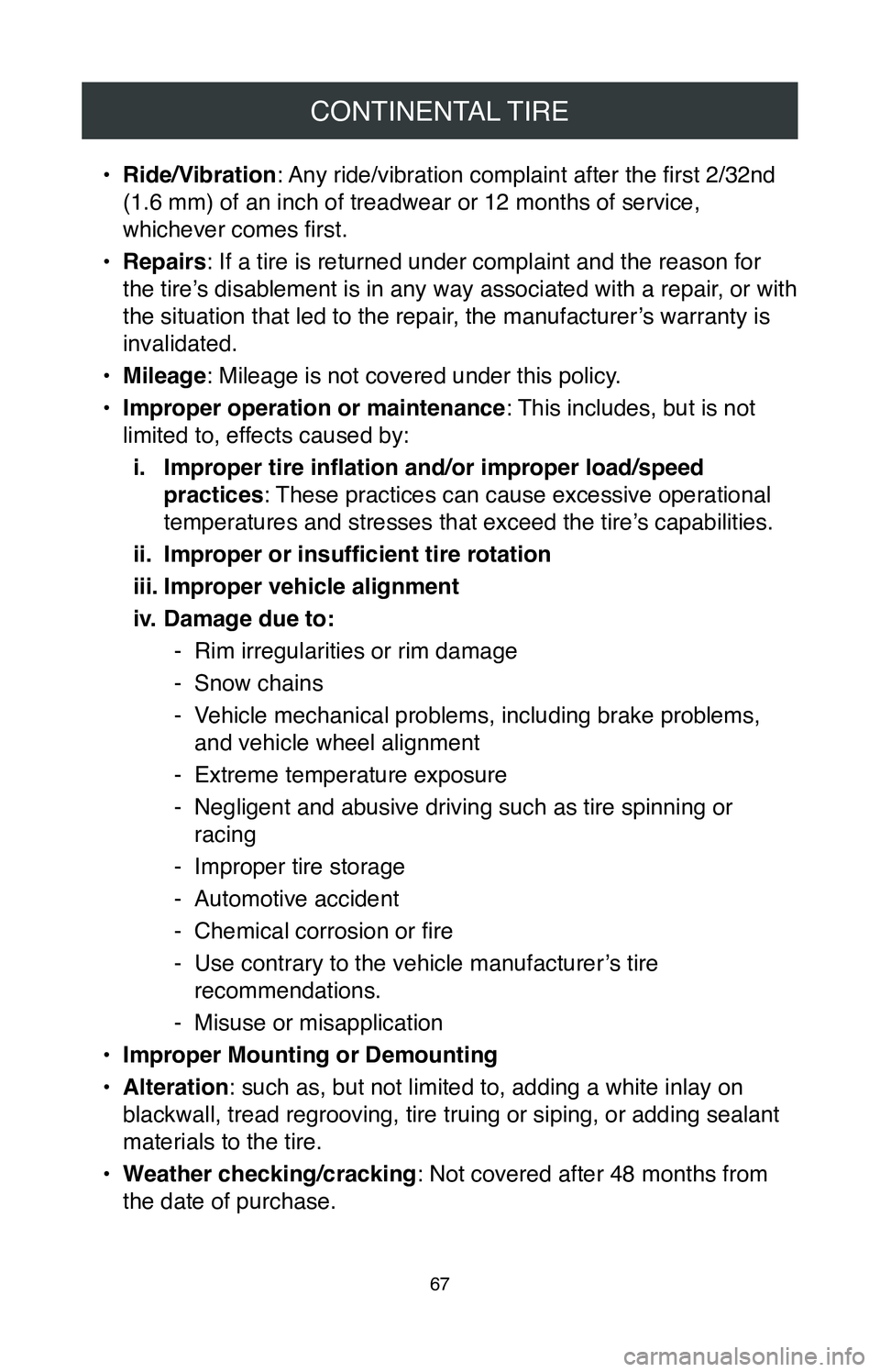
CONTINENTAL TIRE
67
• Ride/Vibration: Any ride/vibration complaint after the first 2/32nd
(1.6 mm) of an inch of treadwear or 12 months of service,
whichever comes first.
•
Repairs: If a tire is returned under complaint and the reason for
the tire’s disablement is in any way associated with a repair, or with
the situation that led to the repair, the manufacturer’s warranty is
invalidated.
•
Mileage: Mileage is not covered under this policy.
•
Improper operation or maintenance : This includes, but is not
limited to, effects caused by:
i.
Improper tire inflation and/or improper load/speed
practices : These practices can cause excessive operational
temperatures and stresses that exceed the tire’s capabilities.
ii.
Improper or insufficient tire rotation
iii.
Improper vehicle alignment
iv.
Damage due to:
- Rim irregularities or rim damage
-Snow chains
-Vehicle mechanical problems, including brake problems,
and vehicle wheel alignment
-Extreme temperature exposure
-Negligent and abusive driving such as tire spinning or
racing
-Improper tire storage
-Automotive accident
- Chemical corrosion or fire
- Use contrary to the vehicle manufacturer’s tire
recommendations.
-Misuse or misapplication
•
Improper Mounting or Demounting
•
Alteration: such as, but not limited to, adding a white inlay on
blackwall, tread regrooving, tire truing or siping, or adding sealant
materials to the tire.
•
Weather checking/cracking: Not covered after 48 months from
the date of purchase.
Page 177 of 260
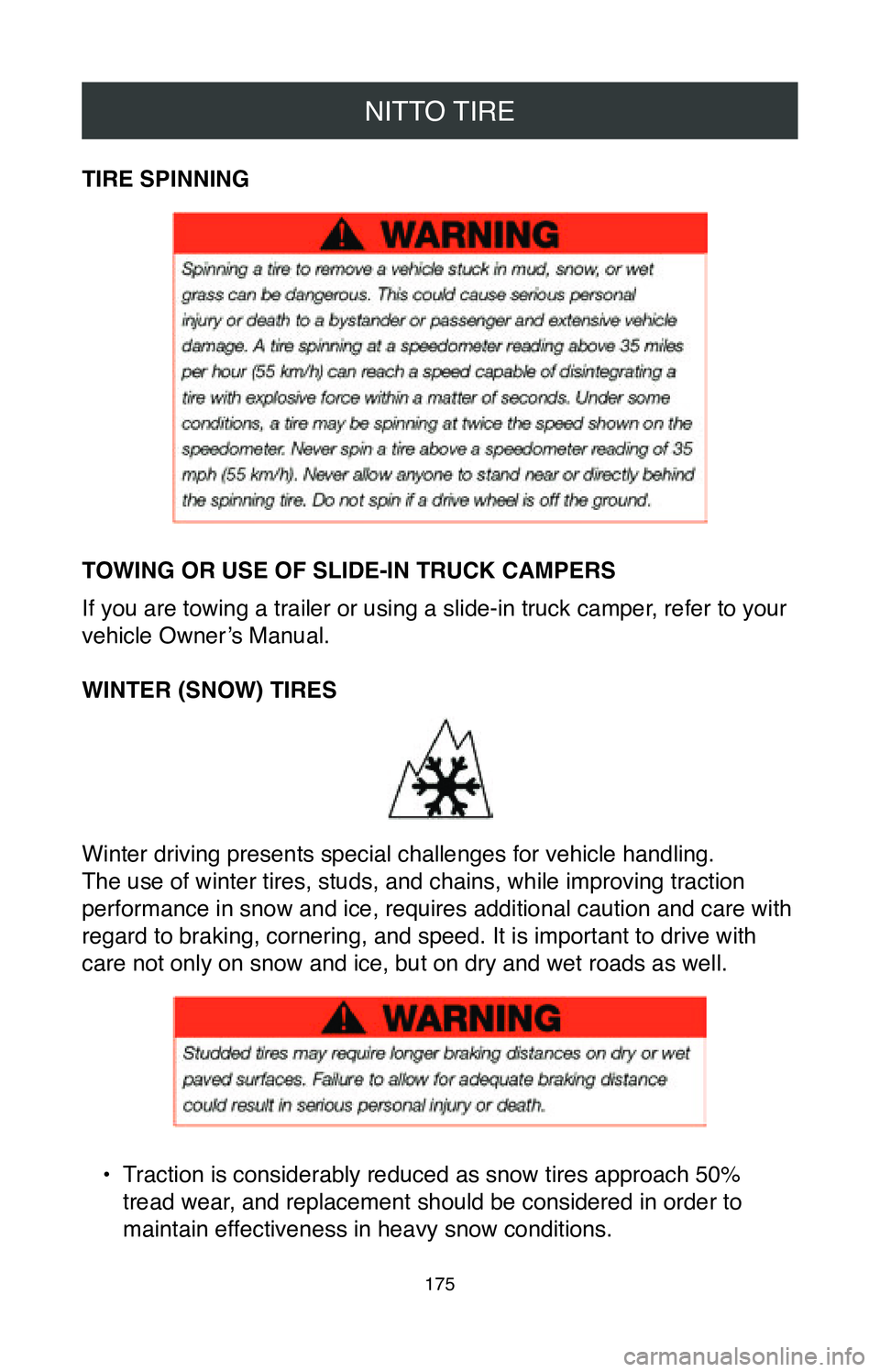
NITTO TIRE
175
TIRE SPINNING
TOWING OR USE OF SLIDE-IN TRUCK CAMPERS
If you are towing a trailer or using a slide-in truck camper, refer to your
vehicle Owner’s Manual.
WINTER (SNOW) TIRES
Winter driving presents special challenges for vehicle handling.
The use of winter tires, studs, and chains, while improving traction
performance in snow and ice, requires additional caution and care with
regard to braking, cornering, and speed. It is important to drive with
care not only on snow and ice, but on dry and wet roads as well.
• Traction is considerably reduced as snow tires approach 50%
tread wear, and replacement should be considered in order to
maintain effectiveness in heavy snow conditions.
Page 178 of 260
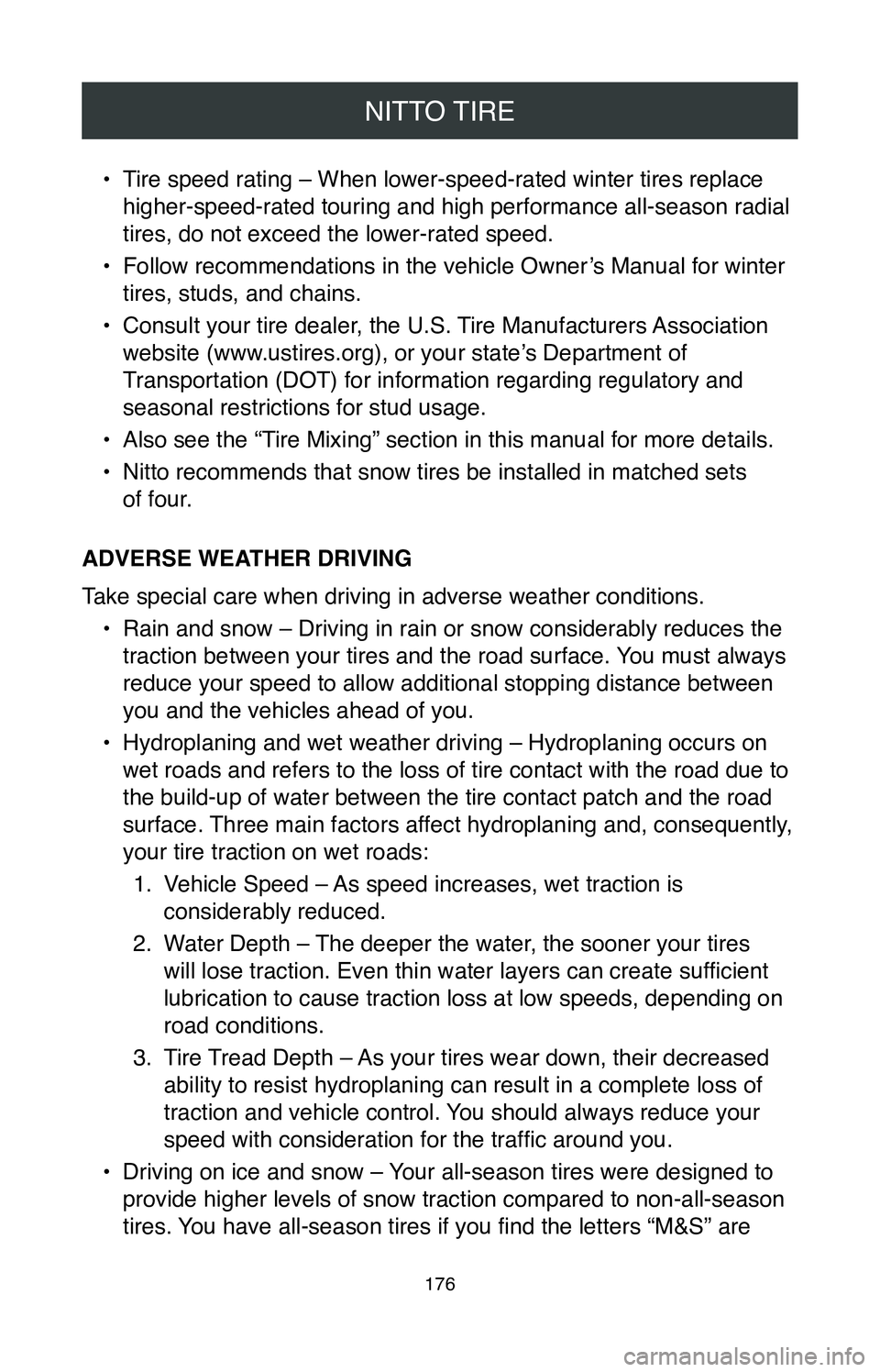
NITTO TIRE
176
• Tire speed rating – When lower-speed-rated winter tires replace
higher-speed-rated touring and high performance all-season radial
tires, do not exceed the lower-rated speed.
•
Follow recommendations in the vehicle Owner’s Manual for winter
tires, studs, and chains.
•
Consult your tire dealer, the U.S. Tire Manufacturers Association
website (www.ustires.org), or your state’s Department of
Transportation (DOT) for information regarding regulatory and
seasonal restrictions for stud usage.
•
Also see the “Tire Mixing” section in this manual for more details.
•
Nitto recommends that snow tires be installed in matched sets
of four.
ADVERSE WEATHER DRIVING
Take special care when driving in adverse weather conditions. •
Rain and snow – Driving in rain or snow considerably reduces the
traction between your tires and the road surface. You must always
reduce your speed to allow additional stopping distance between
you and the vehicles ahead of you.
•
Hydroplaning and wet weather driving – Hydroplaning occurs on
wet roads and refers to the loss of tire contact with the road due to
the build-up of water between the tire contact patch and the road
surface. Three main factors affect hydroplaning and, consequently,
your tire traction on wet roads: 1.
Vehicle Speed – As speed increases, wet traction is
considerably reduced.
2.
Water Depth – The deeper the water, the sooner your tires
will lose traction. Even thin water layers can create sufficient
lubrication to cause traction loss at low speeds, depending on
road conditions.
3.
Tire Tread Depth – As your tires wear down, their decreased
ability to resist hydroplaning can result in a complete loss of
traction and vehicle control. You should always reduce your
speed with consideration for the traffic around you.
•
Driving on ice and snow – Your all-season tires were designed to
provide higher levels of snow traction compared to non-all-season
tires. You have all-season tires if you find the letters “M&S” are
Page 179 of 260
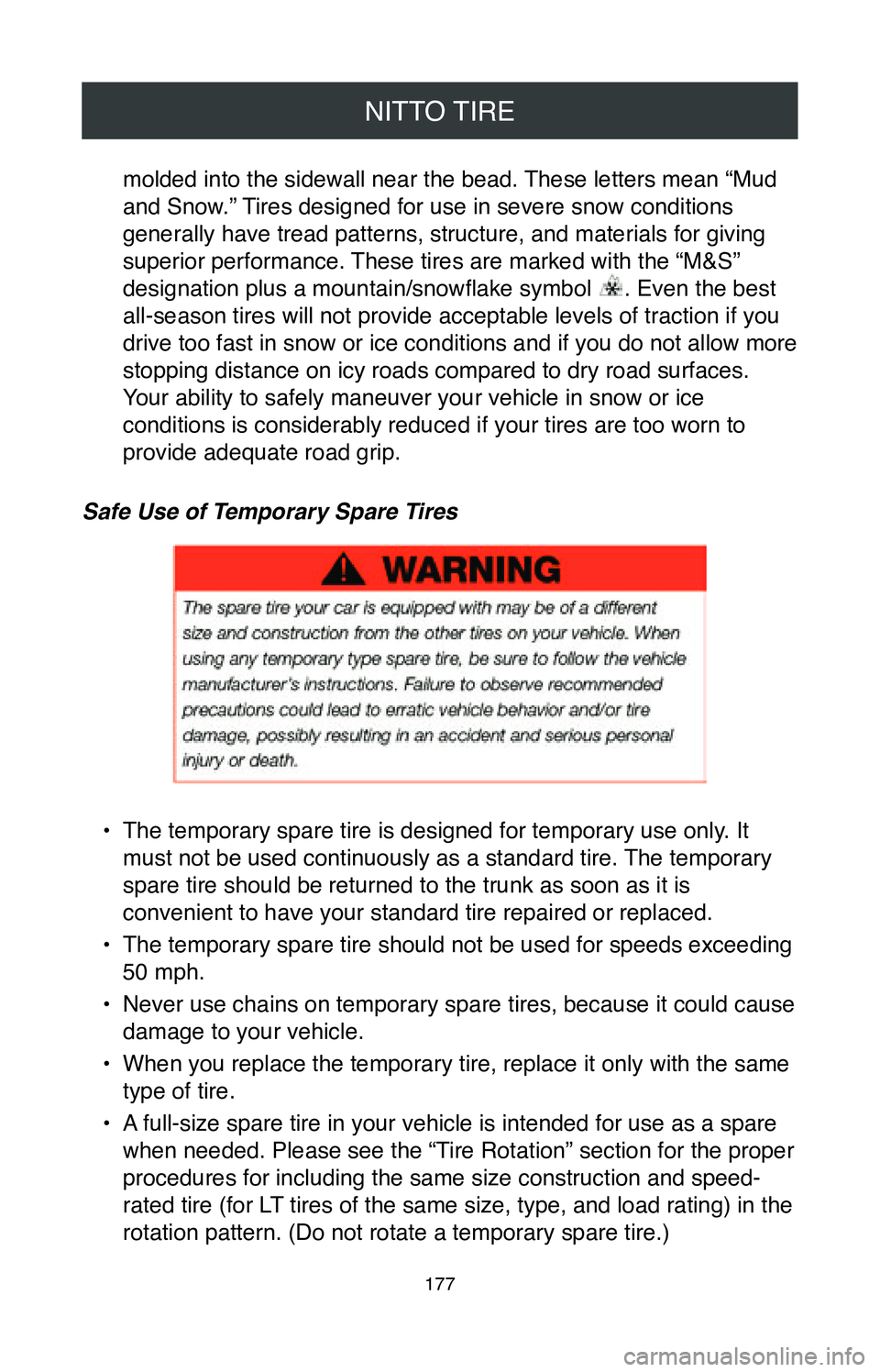
NITTO TIRE
177
molded into the sidewall near the bead. These letters mean “Mud
and Snow.” Tires designed for use in severe snow conditions
generally have tread patterns, structure, and materials for giving
superior performance. These tires are marked with the “M&S”
designation plus a mountain/snowflake symbol
. Even the best
all-season tires will not provide acceptable levels of traction if you
drive too fast in snow or ice conditions and if you do not allow more
stopping distance on icy roads compared to dry road surfaces.
Your ability to safely maneuver your vehicle in snow or ice
conditions is considerably reduced if your tires are too worn to
provide adequate road grip.
Safe Use of Temporary Spare Tires
• The temporary spare tire is designed for temporary use only. It
must not be used continuously as a standard tire. The temporary
spare tire should be returned to the trunk as soon as it is
convenient to have your standard tire repaired or replaced.
•
The temporary spare tire should not be used for speeds exceeding
50 mph.
•
Never use chains on temporary spare tires, because it could cause
damage to your vehicle.
•
When you replace the temporary tire, replace it only with the same
type of tire.
•
A full-size spare tire in your vehicle is intended for use as a spare
when needed. Please see the “Tire Rotation” section for the proper
procedures for including the same size construction and speed-
rated tire (for LT tires of the same size, type, and load rating) in the
rotation pattern. (Do not rotate a temporary spare tire.)
Page 236 of 260
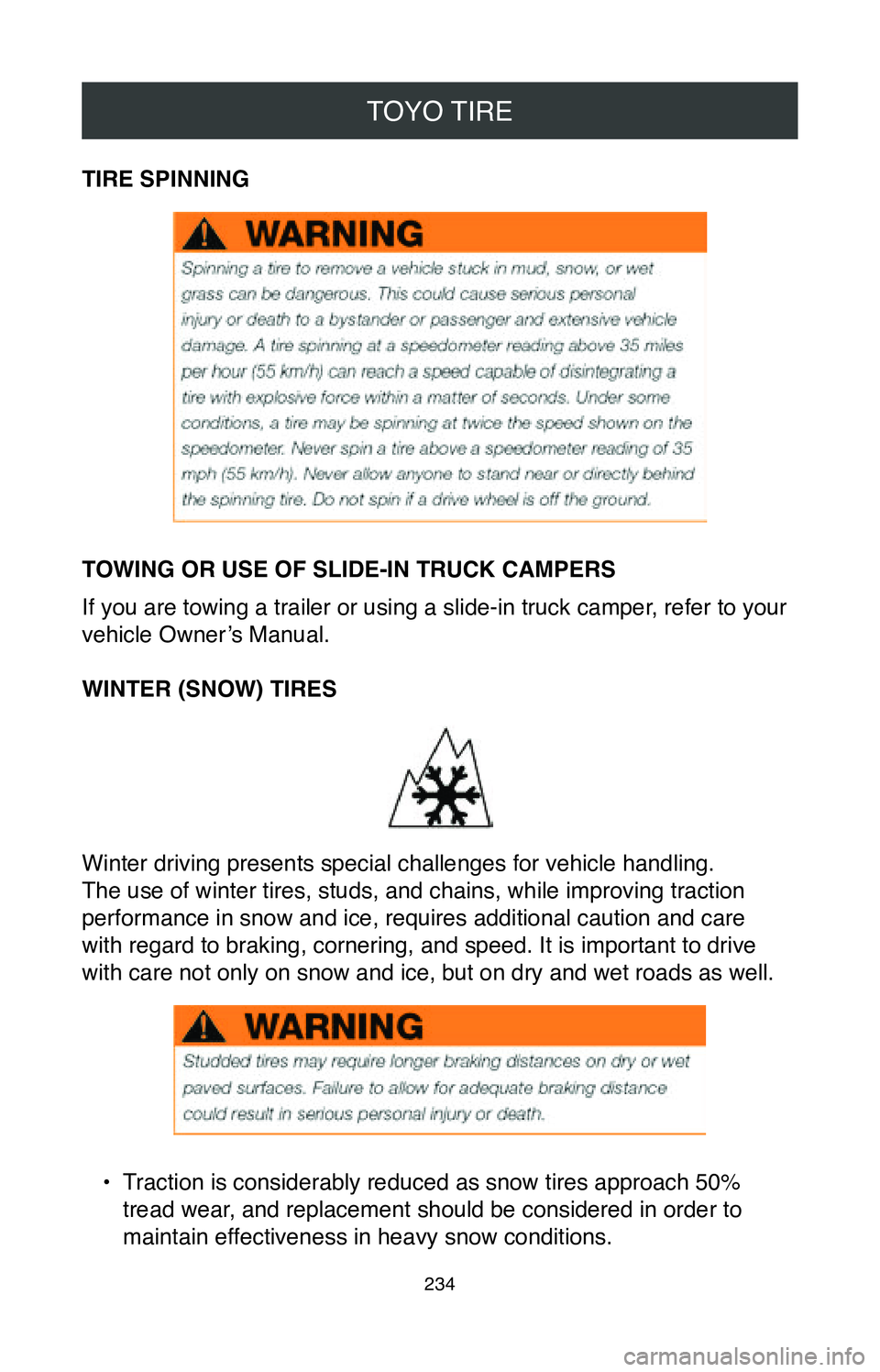
TOYO TIRE
234
TIRE SPINNING
TOWING OR USE OF SLIDE-IN TRUCK CAMPERS
If you are towing a trailer or using a slide-in truck camper, refer to your
vehicle Owner’s Manual.
WINTER (SNOW) TIRES
Winter driving presents special challenges for vehicle handling.
The use of winter tires, studs, and chains, while improving traction
performance in snow and ice, requires additional caution and care
with regard to braking, cornering, and speed. It is important to drive
with care not only on snow and ice, but on dry and wet roads as well.
• Traction is considerably reduced as snow tires approach 50%
tread wear, and replacement should be considered in order to
maintain effectiveness in heavy snow conditions.
Page 237 of 260
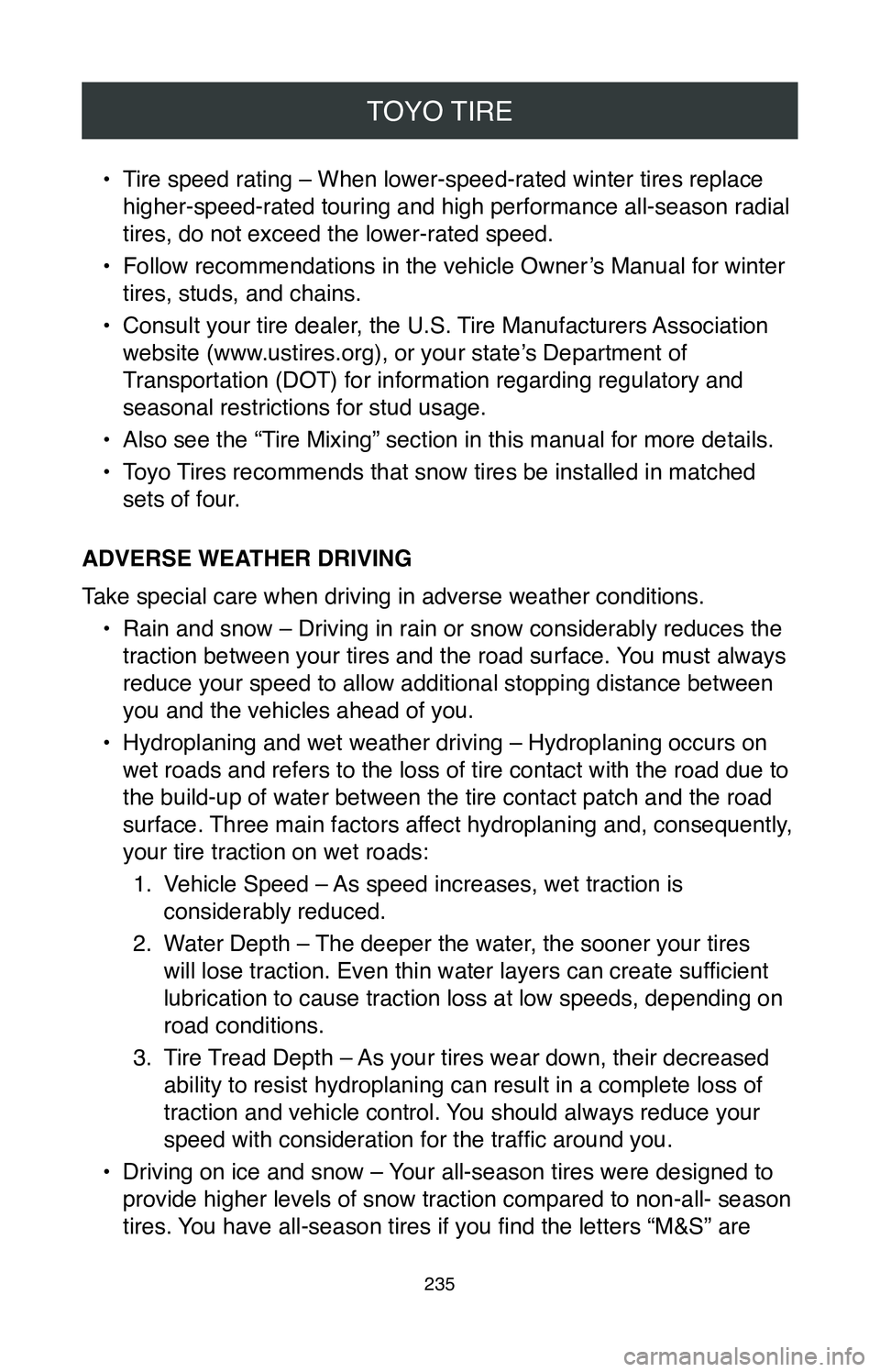
TOYO TIRE
235
• Tire speed rating – When lower-speed-rated winter tires replace
higher-speed-rated touring and high performance all-season radial
tires, do not exceed the lower-rated speed.
•
Follow recommendations in the vehicle Owner’s Manual for winter
tires, studs, and chains.
•
Consult your tire dealer, the U.S. Tire Manufacturers Association
website (www.ustires.org), or your state’s Department of
Transportation (DOT) for information regarding regulatory and
seasonal restrictions for stud usage.
•
Also see the “Tire Mixing” section in this manual for more details.
•
Toyo Tires recommends that snow tires be installed in matched
sets of four.
ADVERSE WEATHER DRIVING
Take special care when driving in adverse weather conditions. •
Rain and snow – Driving in rain or snow considerably reduces the
traction between your tires and the road surface. You must always
reduce your speed to allow additional stopping distance between
you and the vehicles ahead of you.
•
Hydroplaning and wet weather driving – Hydroplaning occurs on
wet roads and refers to the loss of tire contact with the road due to
the build-up of water between the tire contact patch and the road
surface. Three main factors affect hydroplaning and, consequently,
your tire traction on wet roads: 1.
Vehicle Speed – As speed increases, wet traction is
considerably reduced.
2.
Water Depth – The deeper the water, the sooner your tires
will lose traction. Even thin water layers can create sufficient
lubrication to cause traction loss at low speeds, depending on
road conditions.
3.
Tire Tread Depth – As your tires wear down, their decreased
ability to resist hydroplaning can result in a complete loss of
traction and vehicle control. You should always reduce your
speed with consideration for the traffic around you.
•
Driving on ice and snow – Your all-season tires were designed to
provide higher levels of snow traction compared to non-all- season
tires. You have all-season tires if you find the letters “M&S” are
Page 238 of 260
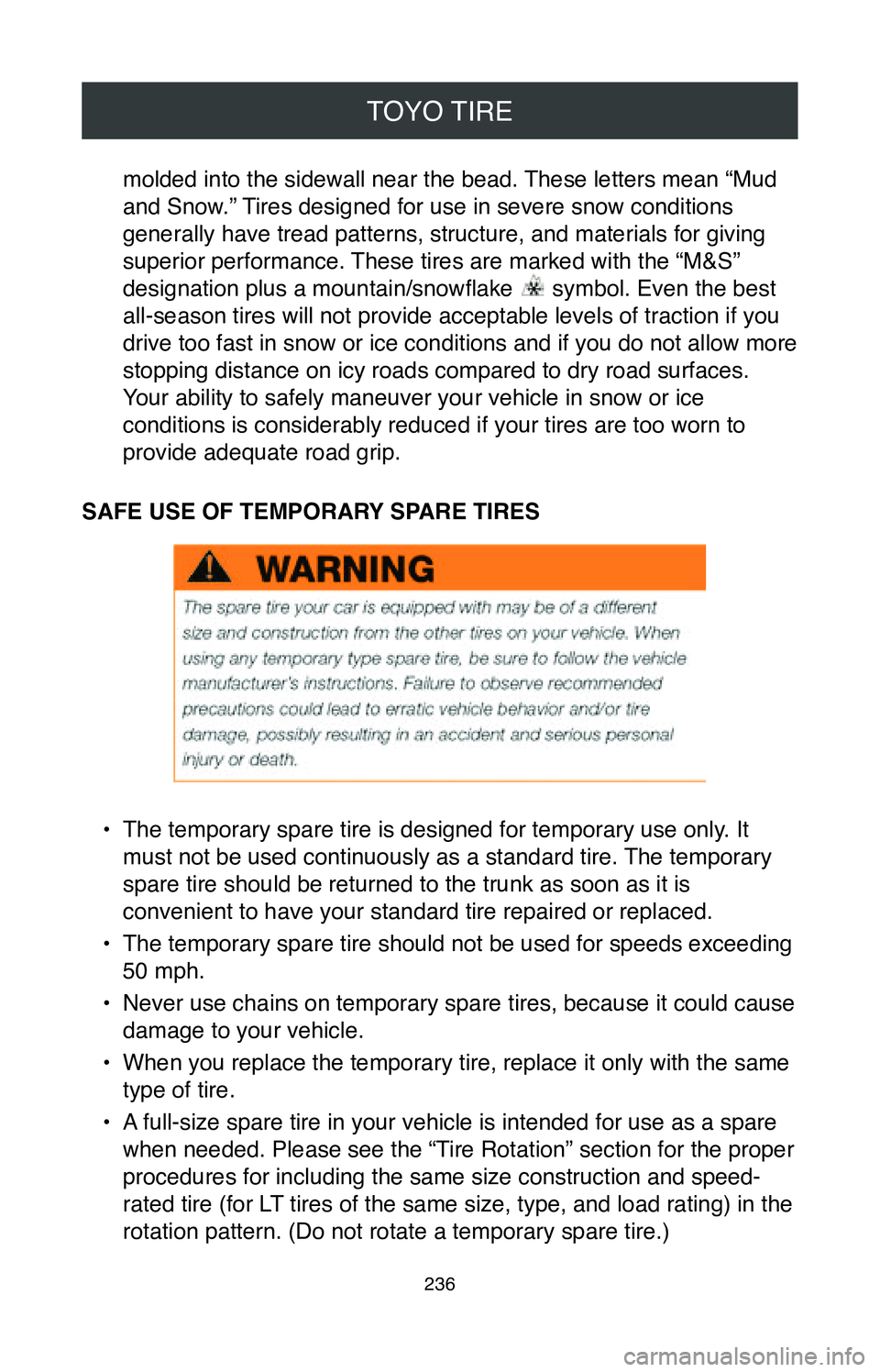
TOYO TIRE
236
molded into the sidewall near the bead. These letters mean “Mud
and Snow.” Tires designed for use in severe snow conditions
generally have tread patterns, structure, and materials for giving
superior performance. These tires are marked with the “M&S”
designation plus a mountain/snowflake
symbol. Even the best
all-season tires will not provide acceptable levels of traction if you
drive too fast in snow or ice conditions and if you do not allow more
stopping distance on icy roads compared to dry road surfaces.
Your ability to safely maneuver your vehicle in snow or ice
conditions is considerably reduced if your tires are too worn to
provide adequate road grip.
SAFE USE OF TEMPORARY SPARE TIRES
• The temporary spare tire is designed for temporary use only. It
must not be used continuously as a standard tire. The temporary
spare tire should be returned to the trunk as soon as it is
convenient to have your standard tire repaired or replaced.
•
The temporary spare tire should not be used for speeds exceeding
50 mph.
•
Never use chains on temporary spare tires, because it could cause
damage to your vehicle.
•
When you replace the temporary tire, replace it only with the same
type of tire.
•
A full-size spare tire in your vehicle is intended for use as a spare
when needed. Please see the “Tire Rotation” section for the proper
procedures for including the same size construction and speed-
rated tire (for LT tires of the same size, type, and load rating) in the
rotation pattern. (Do not rotate a temporary spare tire.)
Page 252 of 260
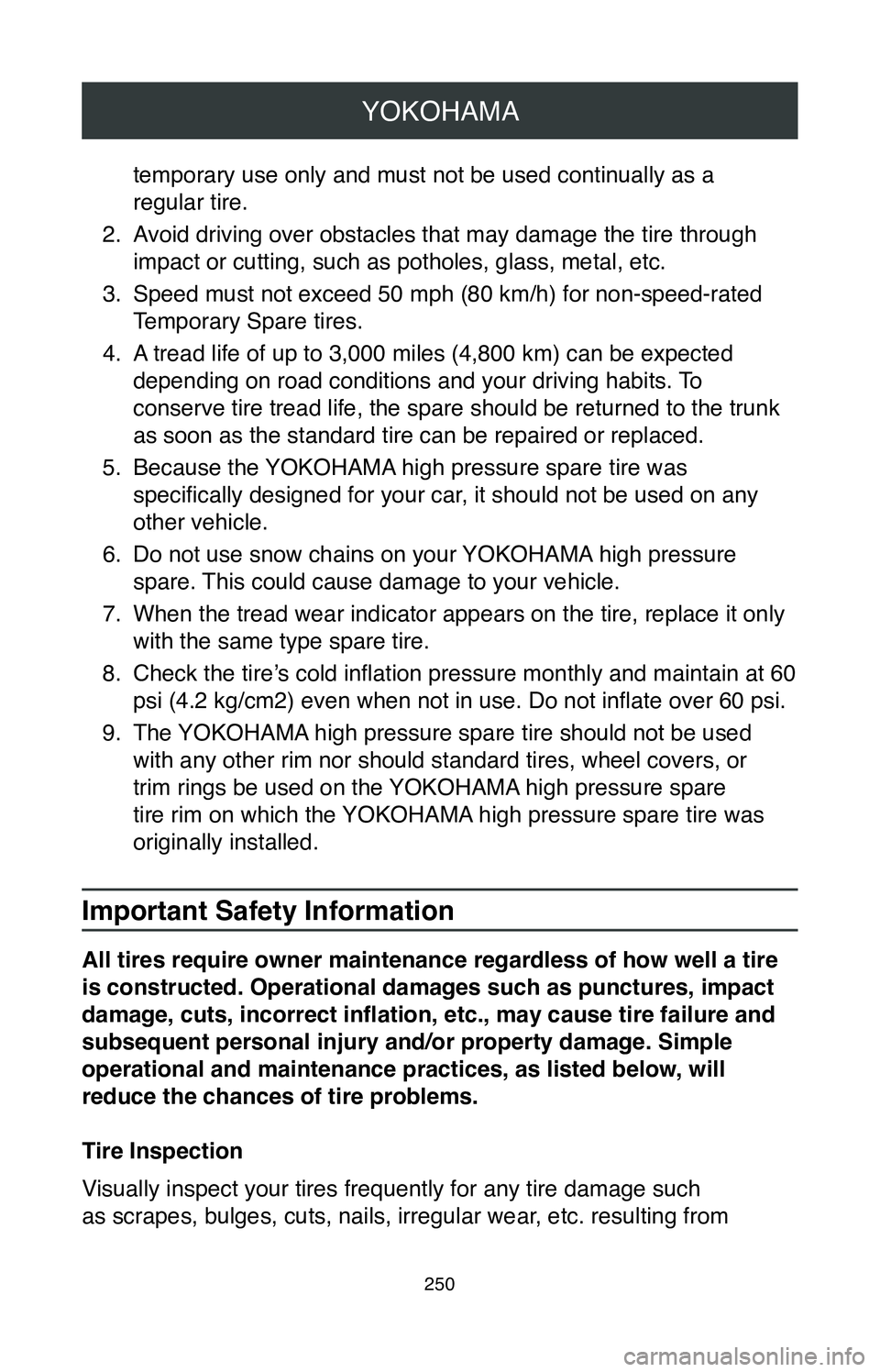
YOKOHAMA
250
temporary use only and must not be used continually as a
regular tire.
2.
Avoid driving over obstacles that may damage the tire through
impact or cutting, such as potholes, glass, metal, etc.
3.
Speed must not exceed 50 mph (80 km/h) for non-speed-rated
Temporary Spare tires.
4.
A tread life of up to 3,000 miles (4,800 km) can be expected
depending on road conditions and your driving habits. To
conserve tire tread life, the spare should be returned to the trunk
as soon as the standard tire can be repaired or replaced.
5.
Because the YOKOHAMA high pressure spare tire was
specifically designed for your car, it should not be used on any
other vehicle.
6.
Do not use snow chains on your YOKOHAMA high pressure
spare. This could cause damage to your vehicle.
7.
When the tread wear indicator appears on the tire, replace it only
with the same type spare tire.
8.
Check the tire’s cold inflation pressure monthly and maintain at 60
psi (4.2 kg/cm2) even when not in use. Do not inflate over 60 psi.
9.
The YOKOHAMA high pressure spare tire should not be used
with any other rim nor should standard tires, wheel covers, or
trim rings be used on the YOKOHAMA high pressure spare
tire rim on which the YOKOHAMA high pressure spare tire was
originally installed.
Important Safety Information
All tires require owner maintenance regardless of how well a tire
is constructed. Operational damages such as punctures, impact
damage, cuts, incorrect inflation, etc., may cause tire failure and
subsequent personal injury and/or property damage. Simple
operational and maintenance practices, as listed below, will
reduce the chances of tire problems.
Tire Inspection
Visually inspect your tires frequently for any tire damage such
as scrapes, bulges, cuts, nails, irregular wear, etc. resulting from